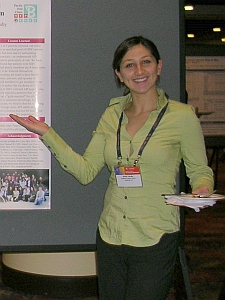Treating a Stealthy Killer:
Hep B Free at the Pacific Free Clinic
Some diseases remain hidden because the population primarily affected is underserved and marginalized due to poverty, language barriers, age, or sexual orientation. Others remain hidden because of the nature of the disease itself, such as AIDS or pancreatic cancer, which attacks the body with few or no symptoms until very late in the course of disease.

The Pacific Free Clinic serves the poor and marginalized in San Jose, California. Within that clinic there is a nucleus of people who serve those who have or are at risk for a stealthy and potentially fatal illness that is often overlooked.
The Hepatitis B Free Clinic (now the Hepatology Clinic) is dedicated to serving all adults who have chronic hepatitis B or who may be infected with the hepatitis B virus (HBV). The clinic is located within a community that is most at risk for hepatitis B -- individuals of Asian or Pacific Island descent. This clinic, which was founded in February 2007 and launched in July 2007, has become a model for community clinics nationwide.
A recent Angels in Medicine article highlighted Dr. Samuel So, Director of the Asian Liver Center at Stanford University and one of the two medical directors of the Hep B Free Clinic. But the founders of the Hep B Free Clinic were not physicians. Steven Lin was a first year medical student and Elizabeth Chao was a doctoral student in biochemistry and a Pacific Free Clinic Manager. Yet both saw an unmet need and gave unsparingly of their time, energy and enthusiasm to bring education and hope to a vulnerable population.
Steven Lin is passionate about addressing hepatitis B. He has firsthand knowledge that its severity goes unrecognized among Asian and Pacific Island peoples. "There's this idea that it's just something you have and there's nothing you can do about it," he said.

The reality is, however, very different. HBV can be transmitted through infected needles, unprotected sex or other situations where the blood of an infected person enters the body of a person who is not infected. Very often the virus is transmitted to a child from the mother during birth. Infection with HBV can become chronic, causing cirrhosis, liver cancer and death, frequently in mid-life, at the height of a person's productivity. Over 350 million people worldwide have chronic HBV infection.
Among Asians, HBV is the leading cause of cirrhosis and liver cancer, even though there is a vaccine to prevent infection and treatment for those already infected. The problem is two-fold: lack of education and limited access to care.
Creating Solutions
Steven Lin and Elizabeth Chao set out to remedy these problems. They wanted to set an example. As recipients of the 2007-2008 U.S. Albert Schweitzer Fellowship, Steven and Elizabeth used their funding to start the clinic.
Beginning with only free screening and counseling, the clinic has been an unqualified success. It now offers a full range of free services, from screening to immunizations to treatment referral and follow-up care. Services are provided mainly by volunteers, most of whom are bilingual or trilingual. Volunteers are undergraduate students, graduate students, medical students, physicians and Stanford alumni. Not all are of Asian and Pacific Island descent. But all are dedicated to providing education and care to this underserved community.
A Volunteer Experience

Nahid Yakuby is an example of a volunteer who is not of Asian descent and yet is dedicated to the Hep B Clinic. The volunteers refer to themselves as Team HBV and Nahid is a passionate member. As an undergraduate in human biology, she was interested in health and pursued various health-related volunteer activities.
After her graduation from Stanford in June 2007, Nahid joined the volunteers at the Hep B Clinic. She was looking for an opportunity to expand her interest in public health while pursuing her application to medical school. After her summer as a volunteer, Nahid was offered a position as staffing coordinator. She is currently in charge of volunteer recruitment and training. But Nahid just can't keep away from the clinic. She continues to volunteer on her days off.
"There are so many rewarding aspects of volunteering there...feeling valued and the memories you create there," she said. "It's also a great learning experience. I've learned a lot about medicine since I've been here," said Nahid. "I'd like you to tell the community that [the Hep B Free Clinic] is a place you can trust." Nahid continued, "We'd also love to have more physician and student volunteers. It's a great place to volunteer."
Serving as a Model
Steven Lin and the others at the Hepatitis B Free Clinic have a mission. "Our goal is to show that it is possible to deliver gold-standard care even in a resource-poor setting," said Steven. With universities across the country beginning to follow the example of this outstanding clinic, this goal is well within reach.
About the Author
Mary Lou Bernardo, PhD, MSN is a freelance health and medical writer in Branford, Connecticut.
About Angels in Medicine
Angels in Medicine is a volunteer site dedicated to the humanitarians, heroes, angels, and bodhisattvas of medicine. The site features physicians, nurses, physician assistants and other healthcare workers and volunteers who reach people without the resources or opportunities for quality care, such as teens, the poor, the incarcerated, the elderly, or those living in poor or war-torn regions. Read their stories at www.medangel.org.